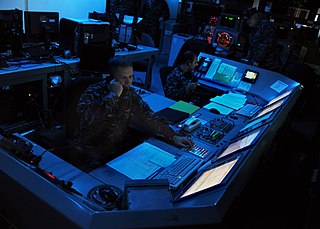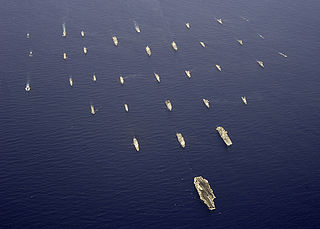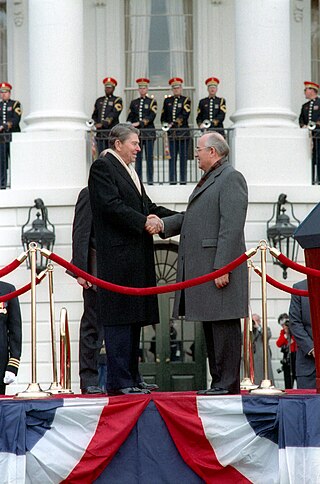Related Research Articles

The Republic of China Armed Forces are the armed forces of the Republic of China (ROC) that once ruled Mainland China and now currently restricted to its territorial jurisdictions of Taiwan, Penghu, Kinmen and Matsu Islands. They consist of the Army, Navy, Air Force and Military Police Force. The military is under the civilian control of the Ministry of National Defense, a cabinet-level agency overseen by the Legislative Yuan.

The People's Liberation Army (PLA) is the armed wing of the Chinese Communist Party (CCP) and the principal military force of the People's Republic of China. The PLA consists of four services — Ground Force, Navy, Air Force, and Rocket Force — and four arms — Aerospace Force, Cyberspace Force, Information Support Force, and Joint Logistics Support Force. It is led by the Central Military Commission (CMC) with its chairman as commander-in-chief.

In political science, a proxy war is as an armed conflict fought between two belligerents, wherein one belligerent is a non-state actor supported by an external third-party power. In the term proxy war, the non-state actor is the proxy, yet both belligerents in a proxy war can be considered proxies if both are receiving foreign military aid from a third party country. Acting either as a nation-state government or as a conventional force, a proxy belligerent acts in behalf of a third-party state sponsor. A proxy war is characterised by a direct, long-term, geopolitical relationship between the third-party sponsor states and their client states and non-state clients, thus the political sponsorship becomes military sponsorship when the third-party powers fund the soldiers and their matériel to equip the belligerent proxy-army to launch and fight and sustain a war to victory, and government power.

Military operations other than war (MOOTW) are military operations that do not involve warfare, combat, or the threat or use of violence. They generally include peacekeeping, peacebuilding, disaster response, humanitarian aid, military engineering, law enforcement, arms control, deterrence, and multilateralism.
Fourth-generation warfare (4GW) is conflict characterized by a blurring of the distinction between war and politics, and of the distinction between combatants and civilians.
In warfare, a theater or theatre is an area in which important military events occur or are in progress. A theater can include the entirety of the airspace, land, and sea area that is—or that may potentially become—involved in war operations.

A blue-water navy is a maritime force capable of operating globally, essentially across the deep waters of open oceans. While definitions of what actually constitutes such a force vary, there is a requirement for the ability to exercise sea control at long range.

The Coast Guard Administration of the Ocean Affairs Council (CGA) is charged with maintaining law and order, protecting the resources of the territorial waters of the Republic of China (Taiwan), which surrounds Taiwan, Penghu, Kinmen, Matsu Islands, Green Island, Orchid Island, Pratas Island (Tungsha/Dongsha), and Nansha Islands as well as providing a first line of defense along coastal areas against smugglers and illegal immigrants. The CGA is considered a civilian law enforcement agency under the administration of the Ocean Affairs Council of the Executive Yuan, though during emergencies it may be incorporated as part of the Republic of China Armed Forces.
Lawfare is the use of legal systems and institutions to damage or delegitimize an opponent, or to deter an individual's usage of their legal rights. The term may refer to the use of legal systems and principles against an enemy, such as by damaging or delegitimizing them, wasting their time and money, or winning a public relations victory. Alternatively, it may describe a tactic used by repressive regimes to label and discourage civil society or individuals from claiming their legal rights via national or international legal systems. This is especially common in situations when individuals and civil society use nonviolent methods to highlight or oppose discrimination, corruption, lack of democracy, limiting freedom of speech, violations of human rights and violations of international humanitarian law.
Seth G. Jones is an academic, political scientist, author, and former senior official in the U.S. Department of Defense. Jones is most renowned for his work on defense strategy, the defense industrial base, irregular warfare, and counterterrrorism. Much of his published work and media interviews are on defense strategy; Chinese, Russian, and Iranian conventional and irregular capabilities and actions; and terrorist and insurgent groups such as al-Qaeda and the Islamic State. He is currently a senior vice president at the Center for Strategic and International Studies.
Economic diplomacy is a form of diplomacy that uses the full spectrum of economic tools of a state to achieve its national interests. The scope of economic diplomacy can encompass all of the international economic activities of a state, including, but not limited to, policy decisions designed to influence exports, imports, investments, lending, aid, free trade agreements, among others.
Operation Giant Lance was a secret U.S. nuclear alert operation by the United States that the Strategic Air Command carried out in late October 1969. Giant Lance was one component of a multi-pronged military exercise, the Joint Chiefs of Staff Readiness Test that the Joint Chiefs developed and carried out during October 1969 in response to White House orders. On October 10, 1969, on the advice of National Security Advisor Henry Kissinger, U.S. President Richard Nixon issued the order for the readiness test that led to Giant Lance.
Hybrid warfare is a theory of military strategy, first proposed by Frank Hoffman, which employs political warfare and blends conventional warfare, irregular warfare, and cyberwarfare with other influencing methods, such as fake news, diplomacy, lawfare, regime change, and foreign electoral intervention. By combining kinetic operations with subversive efforts, the aggressor intends to avoid attribution or retribution. The concept of hybrid warfare has been criticized by a number of academics and practitioners due to its alleged vagueness, its disputed constitutive elements, and its alleged historical distortions.

Full spectrum diplomacy is a combination of traditional, government-to-government diplomacy with the many components of public diplomacy as well as the integration of these two functions with other instruments of statecraft. The term was coined by John Lenczowski, founder and president of The Institute of World Politics in Washington, D.C. in his book Full Spectrum Diplomacy and Grand Strategy: Reforming the Structure and Culture of U.S. Foreign Policy which was released in May, 2011.
Informatized warfare of China is the implementation of information warfare (IW) within the People's Liberation Army (PLA) and other organizations affiliated or controlled by the Chinese Communist Party (CCP). Laid out in the Chinese Defence White Paper of 2008, informatized warfare includes the utilization of information-based weapons and forces, including battlefield management systems, precision-strike capabilities, and technology-assisted command and control (C4ISR). However, some media and analyst report also uses the term to describe the political and espionage effort from the Chinese state.

Political warfare is the use of hostile political means to compel an opponent to do one's will. The term political describes the calculated interaction between a government and a target audience, including another state's government, military, and/or general population. Governments use a variety of techniques to coerce certain actions, thereby gaining relative advantage over an opponent. The techniques include propaganda and psychological operations ("PsyOps"), which service national and military objectives respectively. Propaganda has many aspects and a hostile and coercive political purpose. Psychological operations are for strategic and tactical military objectives and may be intended for hostile military and civilian populations.

The Maritime Militia, also called the Fishing Militia, is one of the three forces, next to the China Coast Guard (CCG) and the People's Liberation Army Navy (PLAN), used in maritime operations by the People’s Republic of China (PRC).
"Three warfares" is an official political and information non-kinetic warfare strategy of the People's Liberation Army (PLA) employing media or public opinion warfare, psychological warfare, and legal warfare. Promulgated as work regulations, the "three warfares" was set forth in the amended Political Work Regulations of the PLA in 2003.

The Gerasimov Doctrine, named after the Chief of the General Staff of the Russian Armed Forces General Valery Gerasimov, is a pseudo-military doctrine created by the Western media and some Russian analysts. It is based on Gerasimov’s views about U.S. contemporary warfare, putting interstate conflict and warfare on a par with political, economic, informational, humanitarian, and other non-military activities. It became known after Mark Galeotti coined the term in his blog "In Moscow Shadows" and the invasion and annexation of Crimea by Russia in 2014. Some Western analysts were convinced that the Russian actions reflected the "Gerasimov Doctrine" helping to spread the term and making it a buzzword.
New generation warfare or NGW is a Russian theory of unconventional warfare which prioritizes the psychological and people-centered aspects over traditional military concerns, and emphasizes a phased approach of non-military influence such that armed conflict, if it arises, is much less costly in human or economic terms for the aggressor than it otherwise would be. It was first enunciated in 2013 by Valery Gerasimov as part of his Gerasimov Doctrine.
References
- 1 2 Dobbs, Thomas; Fallon, Garth; Fouhy, Sarah (9 September 2020). Grey Zone. The Forge (Report). Australian Defence College . Retrieved 18 March 2022.
- ↑ Kapusta, Philip. "The Gray Zone" (PDF). www.soc.mil. United States Special Operations Command. Retrieved 18 February 2021.
- ↑ "Challenging the Grey Zone". www.law.upenn.edu. University of Pennsylvania Law School. Retrieved 18 February 2021.
- ↑ Morris, Lyle J.; Mazarr, Michael J.; Hornung, Jeffrey W.; Pezard, Stephanie; Binnendijk, Anika; Kepe, Marta. "Gaining Competitive Advantage in the Gray Zone" (PDF). www.rand.org. RAND. Retrieved 18 February 2021.
- ↑ Schaus, John; Federici, Joseph; Sheppard, Lindsey. "Gray Zone Project". www.csis.org. CSIS. Retrieved 24 February 2021.
- ↑ Nicholls, Dominic. "SAS ordered to start disrupting Russian meddling around the world". news.yahoo.com. The Telegraph. Retrieved 21 March 2021.
- ↑ Korolev, Alexander (2023). "Political and Economic Security in Eurasia: English School Perspective". China and Eurasian powers in a Multipolar World Order 2.0: Security, Diplomacy, Economy and Cyberspace. Mher Sahakyan. New York: Routledge. p. 11. ISBN 978-1-003-35258-7. OCLC 1353290533.
- ↑ Su-wei, Wu; Chin, Jonathan. "Embrace innovation, admiral says". taipeitimes.com. Taipei Times. Retrieved 17 June 2023.
- ↑ "New US Indo-Pacific commander takes aim at China". Taipei Times . 2024-05-06. Retrieved 2024-05-06.
- ↑ Troeder, Elizabeth G. (2019). A Whole-of-Government Approach to Gray Zone Warfare (Report). Strategic Studies Institute, US Army War College.
- ↑ "Gray Zone". specialforcestraining.info. Retrieved 2024-01-09.
- ↑ Kapusta, Philip (2015-09-09). "White Paper – The Gray Zone" (PDF). specialforcestraining.info. United States Special Operations Command . Retrieved 2024-01-09.
- ↑ Dowse, Andrew; Bachmann, Sascha-Dominik. "Explainer: what is 'hybrid warfare' and what is meant by the 'grey zone'?". theconversation.com. The Conversation. Retrieved 24 February 2021.
- ↑ LEE, YIMOU; LAGUE, DAVID; BLANCHARD, BEN. "China launches 'gray-zone' warfare to subdue Taiwan". www.reuters.com. Reuters. Retrieved 18 February 2021.
- ↑ Chien-pang, Liu; Kui-hsiang, Wen; Lim, Emerson. "Taiwan coast guard ships add new livery to distinguish them from China's". focustaiwan.tw. Focus Taiwan. Retrieved 17 February 2021.
- ↑ Chan, Eric (2 June 2021). "Escalating Clarity without Fighting: Countering Gray Zone Warfare against Taiwan (Part 2)". globaltaiwan.org. The Global Taiwan Institute. Retrieved 21 June 2021.
- 1 2 Belo, Dani; Carment, David. "Grey-Zone Conflict: Implications for Conflict Management". www.cgai.ca. CGAI. Retrieved 24 February 2021.
- ↑ Stoker, Donald; Whiteside, Craig (Winter 2020). "Blurred Lines: Gray-Zone Conflflict and Hybrid War—Two Failures of American Strategic Thinking". Naval War College Review. 73 (1): 1–37.
- ↑ Carment, David; Belo, Dani. "Gray-zone Conflict Management: Theory, Evidence, and Challenges". www.airuniversity.af.edu. Air Force University. Retrieved 18 February 2021.